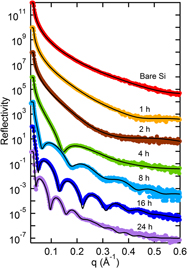Crossref Citations
This article has been cited by the following publications. This list is generated based on data provided by
Crossref.
Rock, William
Oruc, Muhammed E.
Ellis, Ross J.
and
Uysal, Ahmet
2016.
Molecular Scale Description of Anion Competition on Amine-Functionalized Surfaces.
Langmuir,
Vol. 32,
Issue. 44,
p.
11532.
Matthews, Rachael
Glasser, Emily
Sprawls, Samuel C.
French, Roger H.
Peshek, Timothy J.
Pentzer, Emily
and
Martin, Ina T.
2017.
Organofunctional Silane Modification of Aluminum-Doped Zinc Oxide Surfaces as a Route to Stabilization.
ACS Applied Materials & Interfaces,
Vol. 9,
Issue. 20,
p.
17620.
Ielasi, Guido
Hui, Pramiti
Palacio, Carlos
Muñoz, Elías
and
Orellana, Guillermo
2018.
Silane control of the electron injection and oxygen sensitivity of dye-silane-GaN hybrid materials for luminescent chemical sensing.
Sensors and Actuators B: Chemical,
Vol. 254,
Issue. ,
p.
926.
Nowacka, Maria
Rygała, Anna
Kręgiel, Dorota
and
Kowalewska, Anna
2018.
Poly(silsesquioxanes) and poly(siloxanes) grafted with N-acetylcysteine for eradicating mature bacterial biofilms in water environment.
Colloids and Surfaces B: Biointerfaces,
Vol. 172,
Issue. ,
p.
627.
Daza, Rafael
Colchero, Luis
Corregidor, Daniel
Elices, Manuel
Guinea, Gustavo V.
Rojo, Francisco Javier
and
Pérez-Rigueiro, José
2019.
Functionalization of atomic force microscopy cantilevers and tips by activated vapour silanization.
Applied Surface Science,
Vol. 484,
Issue. ,
p.
1141.
Naskar, Nilanjon
Schneidereit, Martin F.
Huber, Florian
Chakrabortty, Sabyasachi
Veith, Lothar
Mezger, Markus
Kirste, Lutz
Fuchs, Theo
Diemant, Thomas
Weil, Tanja
Behm, R. Jürgen
Thonke, Klaus
and
Scholz, Ferdinand
2020.
Impact of Surface Chemistry and Doping Concentrations on Biofunctionalization of GaN/Ga‒In‒N Quantum Wells.
Sensors,
Vol. 20,
Issue. 15,
p.
4179.
Zeeshan, Muhammad
Dilshad, Muhammad Rizwan
Islam, Atif
Iqbal, Sadia Sagar
Akram, Muhammad Sarfraz
Mehmood, Farhan
Gull, Nafisa
and
Khan, Rafi Ullah
2021.
Synergistic effect of silane cross-linker (APTEOS) on PVA/gelatin blend films for packaging applications.
High Performance Polymers,
Vol. 33,
Issue. 7,
p.
815.
Nam, Sangin
Lee, Sung-Min
Kim, Jin
Oh, In-Hyeok
and
Chang, Suk-Tai
2021.
(3-Aminopropyl)Triethoxysilane-Modified Silver Nanowire Network with Strong Adhesion to Coating Substrates for Highly Transparent Electrodes.
Coatings,
Vol. 11,
Issue. 5,
p.
499.
Smits, Joeri
Prasad Giri, Rajendra
Shen, Chen
Mendonça, Diogo
Murphy, Bridget
Huber, Patrick
Rezwan, Kurosch
and
Maas, Michael
2022.
Assessment of nanoparticle immersion depth at liquid interfaces from chemically equivalent macroscopic surfaces.
Journal of Colloid and Interface Science,
Vol. 611,
Issue. ,
p.
670.
Yoon, Jihwan
Han, Geun-Ho
Lee, Min Woo
Lee, Seok-Ho
Lee, Seong Ho
and
Lee, Kwan-Young
2022.
Amine Functionalization Derived Lattice Engineered and Electron Deficient Palladium Catalyst For Selective Production of Hydrogen Peroxide.
SSRN Electronic Journal ,
Yoon, Jihwan
Han, Geun-Ho
Lee, Min Woo
Lee, Seok-Ho
Lee, Seong Ho
and
Lee, Kwan-Young
2022.
Amine functionalization derived lattice engineered and electron deficient palladium catalyst for selective production of hydrogen peroxide.
Applied Surface Science,
Vol. 604,
Issue. ,
p.
154464.
Carvalho, Ana M.
Soares da Costa, Diana
Reis, Rui L.
and
Pashkuleva, Iva
2022.
RHAMM expression tunes the response of breast cancer cell lines to hyaluronan.
Acta Biomaterialia,
Vol. 146,
Issue. ,
p.
187.
Lee, Ganggyu
Lee, Kangchun
Sun, Seho
Song, Taeseup
and
Paik, Ungyu
2023.
Engineering SiO<sub>2</sub> Nanoparticles: A Perspective on Chemical Mechanical Planarization Slurry for Advanced Semiconductor Processing.
KONA Powder and Particle Journal,
Robson, Timothy
Shah, Deepan S. H.
Welbourn, Rebecca J. L.
Phillips, Sion R.
Clifton, Luke A.
and
Lakey, Jeremy H.
2023.
Fully Aqueous Self-Assembly of a Gold-Nanoparticle-Based Pathogen Sensor.
International Journal of Molecular Sciences,
Vol. 24,
Issue. 8,
p.
7599.





